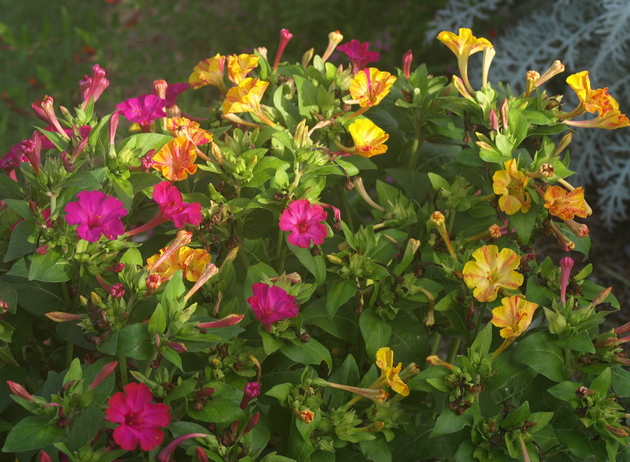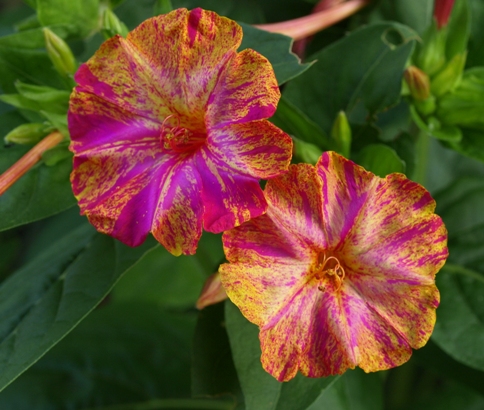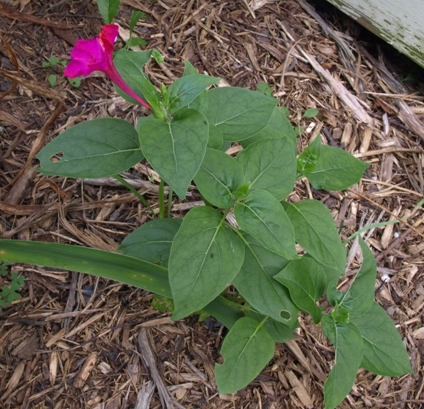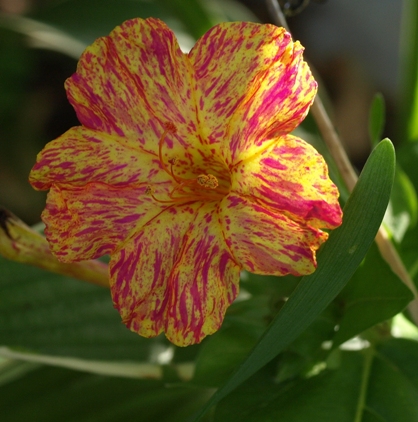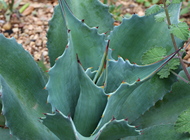 |
Mirabilis jalapa |
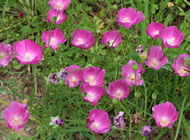 |
| Common name |
four o'clocks |
| Family |
nyctaginaceae |
| Life cycle |
tender perennial (Z7-11) |
| Flowers |
various colors (summer) |
| Size |
24-36" |
| Light |
sun-part shade |
From seed  |
Germinate with bottom heat
detailed seed-starting info below
|
| Seed ripens | extended period, starting early September |
Grown as an annual. That's fair enough for Pennsylvania, where we first grew it, because it's not supposed to be hardy in zone 6. But even in Houston, where cold hardiness should not be an issue, I've not found it to return after winter, although it self-seeds well enough.
Nearly all of my experience is with the variety 'Broken Colors', whose flowers sport interesting color patterns, variously streaked magenta and yellow, with occasional solid-color blooms as well – sometimes on the same plant. My current plants are the result of many generations of seed collected from previous years' gardens, and the patterning still persists.
|
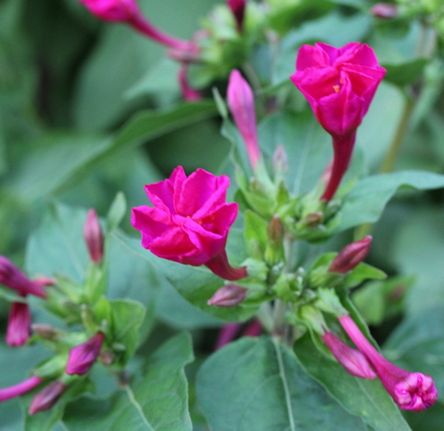
| | Flowers before they fully open |
| 
| | 'Salmon Sunset' |
|
In our garden, this plant grows in the following areas: back fence border, right fence border Seed for this plant is included on my seed trade list One or more images of this plant are included in my stock photo catalog About my plant portraits
PlantLinks to other web pages about Mirabilis jalapa
Visitors to this page have left the following comments| jan rubelmann | Jun 23, 2009 | I found that sowing right into the ground seems to do good. |
| k | Mar 10, 2010 | Soil must be important for these. They grew pectacularly for me in Ithaca NY (the flowers come out only in late afternoon though). Very lackluster though last season on Cape Cod MA. |
| Glenn Steinberg | Mar 29, 2011 | You should dig up the roots in the fall and re-plant in the spring. The roots get bigger and bigger with a large, potato-like tuber just below the stem of the plant. The roots can be stored dry in a paper bag in a cool place. I've had good years and not-so-good years. In the good years, the plants get HUGE (2-3 feet high and maybe 4 or more feet spread) with hundreds, if not thousands, of blooms. In bad years, the plants stay relatively small, look a little straggly, but still bloom prolifically. I'm not sure why the good years are good and the bad years, bad, however. |
| Jan St. Germain | Jun 15, 2012 | I just noticed these things in my back yard up against the house. They popped up out of no where. I started watering other plants that I had put in the ground in that particular area - thinking they were the only things there. They came out of NOWHERE! I didn't plant them. The people who had the house before me may have...? Apparently they were lying dormant. They are beautiful plants. I'm in Zone 7 (Albuquerque, NM) - I've read some info on these saying they are annuals. I don't know about that! |
- Seed for 'Broken Colors' from '07 trade. Baggy 75F (100%G, 4-8d)
- Seed from '08 garden. Baggy 75F (44%G, 4-6d)
- Seed from '09 garden. Baggy 75F (92%G, 4-11d)
- Seed from garden. Baggy 75F (67%G, 4-6d)
- Same seed as above. Baggy 75F (30%G, 8-12d)
- Same seed as above. Baggy 75F (47%G, 8-16d)
- Seed for 'Broken Colors' from '14 garden. Baggy 75F (90%G, 6-13d)
- Seed for 'Broken Colors' from '14 garden. Baggy 70F (78%G, 6-12d)
- Same seed as above. Baggy 70F (67%G, 7-11d)
I welcome comments about my web pages; feel free to use the form below to
leave feedback about this particular page. For the benefit of other visitors
to these pages, I will list any relevant comments you leave, and if
appropriate, I will update my page to correct mis-information. Faced with an
ever-increasing onslaught of spam, I'm forced to discard any comments including
html markups. Please submit your comment as plain text. If you have a
comment about the website as a whole, please leave it in my
guestbook. If you
have a question that needs a personal response, please
e-mail me.
Last modified:
June 02, 2025
Contact me
|


